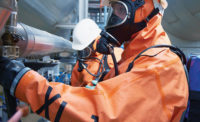Have you experienced the distinctive “rotten egg” smell of a hazardous gas called hydrogen sulfide (H2S)?
Occurring naturally from organic decay, for example, around sewage plants, H2S can be found in crude petroleum and natural gas — often in very high concentrations. Even at very low concentrations, 0.00047 ppm or 0.47 ppb, humans can begin to smell H2S.1 This is responsible for thousands of “nuisance odor” litigations and multimillion-dollar awards against oil and gas producers.
A unique property of H2S is that humans can easily smell it at very low levels. As the levels increase, the olfactory senses stop smelling it and one is no longer even aware of the danger. At 10 ppm levels of H2S, the OSHA permissible exposure limit (PEL) (8-hour time-weighted average) for human exposure is reached. The immediate danger to life and health (IDLH) for H2S is currently 100 ppm. In sour crude oil and gas wells H2S concentrations often exceed these levels. A recent report estimates environmental, health and safety spending in this industry is expected to increase from $35 billion in 2011 to $56 billion by 2030.2
In sour crude oil and gas wells, H2S concentrations often greatly exceed toxic levels. At higher concentrations air/H2S mixtures become explosive. The gas is flammable and forms explosive mixtures in a range of 4.3 to 45.5 percent by volume in air.
H2S is a problem for personal safety, and very costly to the oil and gas industry because H2S enhances corrosion. The total annual cost of corrosion in the oil and gas production industry is estimated to be $1.372 billion.3
Corrosion commonly causes serious environmental problems, such as spills and releases. As offshore exploration moves into deeper wells with increased levels of H2S, the problem will increase. H2S causes significant corrosion problems to the metal pipes, drills, pipelines that are required to transport and extract oil and gas.
Colorimetric tape measurements of H2S
The hazardous properties of H2S necessitate measuring H2S reliably over a range of concentrations and in the gaseous (natural gas) and liquid phases (crude oil). Most safety professionals have encountered the simplest practical measurement method based on colorimetric chemistry5. Simply break the glass tube on both ends and pump a sample across a chemically impregnated matrix. The tube changes color if the substance is present.
About 30 years ago, it was realized similar chemicals could be applied to paper tapes for continuous analyzers. Despite the advances in electrochemical techniques, tunable diode lasers and FTIR, among others, this venerable technology continues to be a go-to technology for measuring H2S.4
Colorimetric tape technology
Detecting H2S concentrations is achieved by exposing a sample containing H2S to the surface of a tape impregnated with a chemical. Lead acetate type formulations are commonly employed, although there are numerous chemicals available that produce color changes when exposed to H2S. The sample can be either liquid or gas. For gaseous measurements, the sample is commonly blown on the surface of or through the tape. For liquid samples, a small amount of the liquid stream is bled off and dripped on to tape. The tape visibly changes color. The rate and intensity of the color change is monitored via various light sources and detectors in a straightforward way. The amount of H2S present is proportional to the rate of increase and intensity of the color change. Periodically, the tape is advanced to expose the sample to fresh chemicals.
Benefits
You can routinely achieve PPB measurements and well into the 1000 PPM range, reproducibly, with the same paper tape analyzer. No field calibration or calibration gases are required as the tape is calibrated at the time of manufacture. Ever-evolving chemical formulations and better detection technologies will improve this technology in the future.
References
- See the H2S Fact Sheet from the Occupational Safety and Health Administration (OSHA), 1995.
- Lux Research Report, April 19, 2013.
- Oil and Gas “Rust:” An Evil Worse Than Depletion, May 2008 Offshore Technology Conference (OTC) Presentation.
- See, for example, Corrosion problems during oil and gas production and its mitigation, International Journal of Industrial Chemistry, Dec 2013.
- See the “History of Draeger Publication”, available at www.draeger.com.

